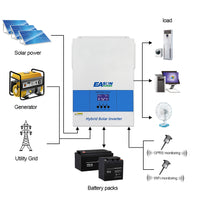As the demand for renewable energy sources continues to grow, the development of energy-efficient inverters for solar-to-electric conversion has become increasingly important. In this article, we will explore the latest innovations in this field and their impact on the renewable energy industry.

Advancements in Power Electronics
The latest innovations in energy-efficient inverters for solar-to-electric conversion have been driven by advancements in power electronics. These innovations have led to the development of inverters that are not only more efficient in converting solar energy into electricity but also more reliable and cost-effective. For example, the use of wide-bandgap semiconductors such as silicon carbide (SiC) and gallium nitride (GaN) has significantly improved the efficiency and power density of inverters, making them ideal for solar power systems.
Smart Inverter Technology
Another significant innovation in energy-efficient inverters is the integration of smart technology. Smart inverters are capable of communicating with the grid and adjusting their output based on the grid's requirements. This not only improves the stability and reliability of the grid but also enables the seamless integration of solar power into the existing infrastructure. Furthermore, smart inverters can provide valuable data on energy production and consumption, allowing for better management of solar power systems.
Modular and Scalable Designs
Modular and scalable designs have also emerged as a key innovation in energy-efficient inverters for solar-to-electric conversion. These designs allow for greater flexibility in system configuration and expansion, making it easier to adapt to varying power requirements. By using modular inverters, solar power systems can be easily customized to meet the specific needs of residential, commercial, and utility-scale applications. This scalability not only improves the overall efficiency of the system but also reduces installation and maintenance costs.
Enhanced Grid Support Functions
Lastly, the latest innovations in energy-efficient inverters include enhanced grid support functions. In addition to converting solar energy into electricity, modern inverters are equipped with advanced features that support the stability and reliability of the grid. These functions include voltage and frequency regulation, reactive power control, and anti-islanding protection. By providing grid support, energy-efficient inverters contribute to the seamless integration of solar power and help address the challenges associated with the variability of renewable energy sources.
In conclusion, the latest innovations in energy-efficient inverters for solar-to-electric conversion have significantly advanced the capabilities of solar power systems. From advancements in power electronics to the integration of smart technology and modular designs, these innovations have improved the efficiency, reliability, and flexibility of solar power systems. As the renewable energy industry continues to evolve, energy-efficient inverters will play a crucial role in driving the widespread adoption of solar power as a clean and sustainable energy source.









